Mathias Fink
Fingerprint Matrix Concept for Detecting, Localizing and Characterizing Targets in Complex Media
Feb 10, 2025Abstract:As waves propagate through a complex medium, they undergo multiple scattering events. This phenomenon is detrimental to imaging, as it causes a full blurring of the image beyond a transport mean free path. Here, we show how to detect, localize, and characterize any scattering target through the reflection matrix of the complex medium in which this target is embedded and thus hidden from direct view. More precisely, we introduce a fingerprint operator that contains the specific signature of the target with respect to its environment. Applied to the recorded reflection matrix, this operator provides a likelihood index of the target in any given state, despite the scattering fog induced by the surrounding environment. This state can be the target position for localization purposes, its shape for characterization, or any other parameter that influences the target response. Our concept is versatile and broadly applicable to different type of waves for which multi-element technology allows a reflection matrix to be measured. We demonstrate this here explicitly by performing different proof-of-concept experiments with ultrasound on targets buried inside a strongly scattering granular suspension, on lesion markers for clinical applications, and on the architecture of muscle tissue.
Ultrasound matrix imaging for transcranial in-vivo localization microscopy
Oct 18, 2024Abstract:Transcranial ultrasound imaging is usually limited by skull-induced attenuation and high-order aberrations. By using contrast agents such as microbubbles in combination with ultrafast imaging, not only can the signal-to-noise ratio be improved, but super-resolution images down to the micrometer scale of the brain vessels can be obtained. However, ultrasound localization microscopy (ULM) remains impacted by wave-front distortions that limit the microbubble detection rate and hamper their localization. In this work, we show how matrix imaging, which relies on the prior recording of the reflection matrix, can provide a solution to those fundamental issues. As an experimental proof-of-concept, an in-vivo reconstruction of deep brain microvessels is performed on three anesthetized sheeps. The compensation of wave distortions is shown to drastically enhance the contrast and resolution of ULM. This experimental study thus opens up promising perspectives for a transcranial and non-ionizing observation of human cerebral microvascular pathologies, such as stroke.
Reflection Matrix Imaging for Wave Velocity Tomography
Sep 20, 2024Abstract:Besides controlling wave trajectory inside complex media, wave velocity constitutes a relevant bio-marker for medical imaging. In a transmission configuration, wave-front distortions can be unscrambled to provide a map of the wave velocity landscape $c(\mathbf{r})$. However, most in-vivo applications correspond to a reflection configuration for which only back-scattered echoes generated by short-scale fluctuations of $c(\mathbf{r})$ can be harvested. Under a single scattering assumption, this speckle wave-field cannot provide the long-scale variations of $c(\mathbf{r})$. In this paper, we go beyond the first Born approximation and show how a map of $c(\mathbf{r})$ can be retrieved in epi-detection. To that aim, a reflection matrix approach of wave imaging is adopted. While standard reflection imaging methods generally rely on confocal focusing operations, matrix imaging consists in decoupling the location of the incident and received focal spots. Following this principle, a self-portrait of the focusing process can be obtained around each point of the medium. The Gouy phase shift exhibited by each focal spot is leveraged to finely monitor the wave velocity distribution $c(\mathbf{r})$ inside the medium. Experiment in a tissue-mimicking phantom and numerical simulations are first presented to validate our method. Speed-of-sound tomography is then applied to ultrasound data collected on the liver of a difficult-to-image patient. Beyond paving the way towards quantitative ultrasound, our approach can also be extremely rewarding for standard imaging. Indeed, each echo can be assigned to the actual position of a scatterer. It allows an absolute measurement of distance, an observable often used for diagnosis but generally extremely sensitive to wave velocity fluctuations.
Unveiling the deep plumbing system of a volcano by a reflection matrix analysis of seismic noise
Nov 02, 2023



Abstract:In geophysics, volcanoes are particularly difficult to image because of the multi-scale heterogeneities of fluids and rocks that compose them and their complex non-linear dynamics. By exploiting seismic noise recorded by a sparse array of geophones, we are able to reveal the magmatic and hydrothermal plumbing system of La Soufri\`ere volcano in Guadeloupe. Spatio-temporal cross-correlation of seismic noise actually provides the impulse responses between virtual geophones located inside the volcano. The resulting reflection matrix can be exploited to numerically perform an auto-focus of seismic waves on any reflector of the underground. An unprecedented view on the volcano's inner structure is obtained at a half-wavelength resolution. This innovative observable provides fundamental information for the conceptual modeling and high-resolution monitoring of volcanoes.
On the Sum Secrecy Rate of Multi-User Holographic MIMO Networks
Oct 22, 2023



Abstract:The emerging concept of extremely-large holographic multiple-input multiple-output (HMIMO), beneficial from compactly and densely packed cost-efficient radiating meta-atoms, has been demonstrated for enhanced degrees of freedom even in pure line-of-sight conditions, enabling tremendous multiplexing gain for the next-generation communication systems. Most of the reported works focus on energy and spectrum efficiency, path loss analyses, and channel modeling. The extension to secure communications remains unexplored. In this paper, we theoretically characterize the secrecy capacity of the HMIMO network with multiple legitimate users and one eavesdropper while taking into consideration artificial noise and max-min fairness. We formulate the power allocation (PA) problem and address it by following successive convex approximation and Taylor expansion. We further study the effect of fixed PA coefficients, imperfect channel state information, inter-element spacing, and the number of Eve's antennas on the sum secrecy rate. Simulation results show that significant performance gain with more than 100\% increment in the high signal-to-noise ratio (SNR) regime for the two-user case is obtained by exploiting adaptive/flexible PA compared to the case with fixed PA coefficients.
Multi-Spectral Reflection Matrix for Ultra-Fast 3D Label-Free Microscopy
Sep 19, 2023Abstract:Label-free microscopy exploits light scattering to obtain a three-dimensional image of biological tissues. However, light propagation is affected by aberrations and multiple scattering, which drastically degrade the image quality and limit the penetration depth. Multi-conjugate adaptive optics and time-gated matrix approaches have been developed to compensate for aberrations but the associated frame rate is extremely limited for 3D imaging. Here we develop a multi-spectral matrix approach to solve these fundamental problems. Based on an interferometric measurement of a polychromatic reflection matrix, the focusing process can be optimized in post-processing at any voxel by addressing independently each frequency component of the wave-field. A proof-of-concept experiment demonstrates the three-dimensional image of an opaque human cornea over a 0.1 mm^3-field-of-view at a 290 nm-resolution and a 1 Hz-frame rate. This work paves the way towards a fully-digital microscope allowing real-time, in-vivo, quantitative and deep inspection of tissues.
Optimizing multi-user sound communications in reverberating environments with acoustic reconfigurable metasurfaces
Aug 03, 2023Abstract:How do you ensure that, in a reverberant room, several people can speak simultaneously to several other people, making themselves perfectly understood and without any crosstalk between messages? In this work, we report a conceptual solution to this problem by developing an intelligent acoustic wall, which can be reconfigured electronically and is controlled by a learning algorithm that adapts to the geometry of the room and the positions of sources and receivers. To this end, a portion of the room boundaries is covered with a smart mirror made of a broadband acoustic reconfigurable metasurface (ARMs) designed to provide a two-state (0 or {\pi}) phase shift in the reflected waves by 200 independently tunable units. The whole phase pattern is optimized to maximize the Shannon capacity while minimizing crosstalk between the different sources and receivers. We demonstrate the control of multi-spectral sound fields covering a spectrum much larger than the coherence bandwidth of the room for diverse striking functionalities, including crosstalk-free acoustic communication, frequency-multiplexed communications, and multi-user communications. An experiment conducted with two music sources for two different people demonstrates a crosstalk-free simultaneous music playback. Our work opens new routes for the control of sound waves in complex media and for a new generation of acoustic devices.
Three-Dimensional Ultrasound Matrix Imaging
Mar 13, 2023Abstract:Matrix imaging paves the way towards a next revolution in wave physics. Based on the response matrix recorded between a set of sensors, it enables an optimized compensation of aberration phenomena and multiple scattering events that usually drastically hinder the focusing process in heterogeneous media. Although it gave rise to spectacular results in optical microscopy or seismic imaging, the success of matrix imaging has been so far relatively limited with ultrasonic waves because wave control is generally only performed with a linear array of transducers. In this paper, we extend ultrasound matrix imaging to a 3D geometry. Switching from a 1D to a 2D probe enables a much sharper estimation of the transmission matrix that links each transducer and each medium voxel. Here, we first present an experimental proof of concept on a tissue-mimicking phantom through ex-vivo tissues and then, show the potential of 3D matrix imaging for transcranial applications.
Time Reversal for 6G Spatiotemporal Focusing: Recent Experiments, Opportunities, and Challenges
Jun 16, 2022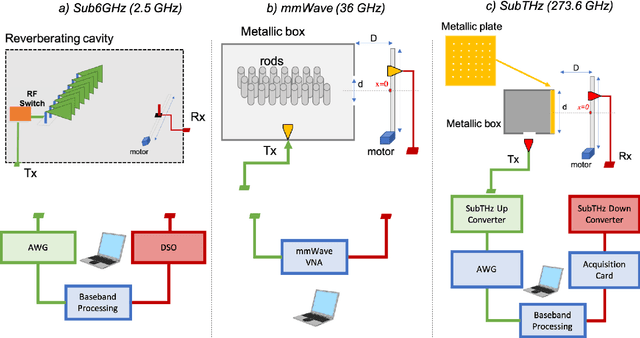
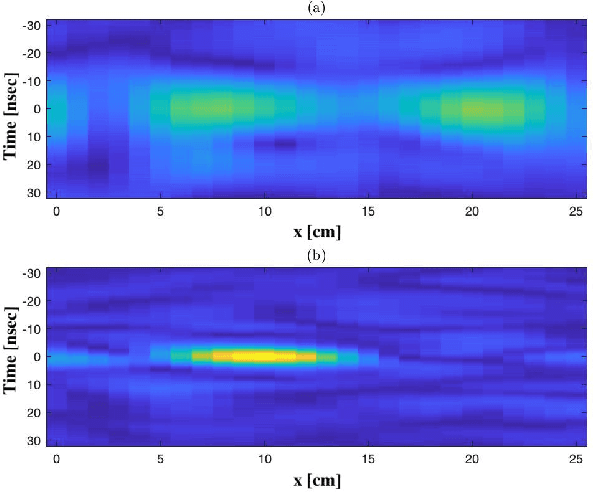
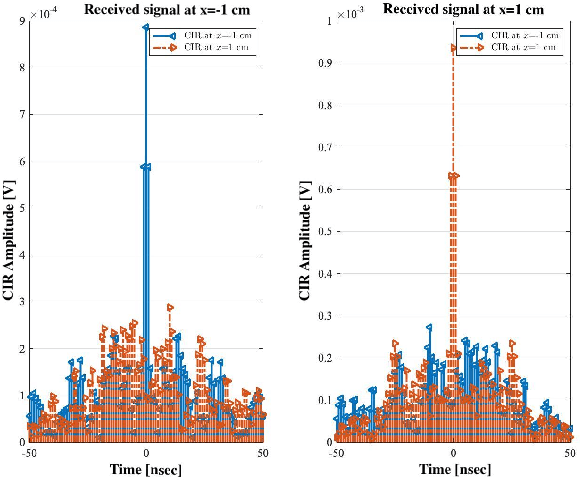
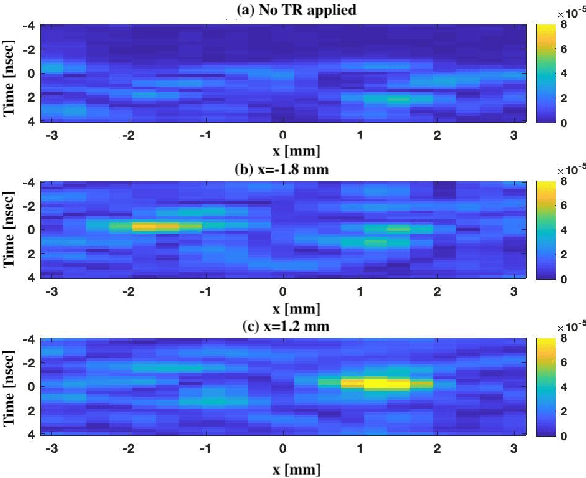
Abstract:Late visions and trends for the future sixth Generation (6G) of wireless communications advocate, among other technologies, towards the deployment of network nodes with extreme numbers of antennas and up to terahertz frequencies, as means to enable various immersive applications. However, these technologies impose several challenges in the design of radio-frequency front-ends and beamforming architectures, as well as of ultra-wideband waveforms and computationally efficient transceiver signal processing. In this article, we revisit the Time Reversal (TR) technique, which was initially experimented in acoustics, in the context of large-bandwidth 6G wireless communications, capitalizing on its high resolution spatiotemporal focusing realized with low complexity transceivers. We first overview representative state-of-the-art in TR-based wireless communications, identifying the key competencies and requirements of TR for efficient operation. Recent and novel experimental setups and results for the spatiotemporal focusing capability of TR at the carrier frequencies $2.5$, $36$, and $273$ GHz are then presented, demonstrating in quantitative ways the technique's effectiveness in these very different frequency bands, as well as the roles of the available bandwidth and the number of transmit antennas. We also showcase the TR potential for realizing low complexity multi-user communications. The opportunities arising from TR-based wireless communications as well as the challenges for finding their place in 6G networks, also in conjunction with other complementary candidate technologies, are highlighted.
Time Reversal Precoding at SubTHz Frequencies: Experimental Results on Spatiotemporal Focusing
Mar 29, 2022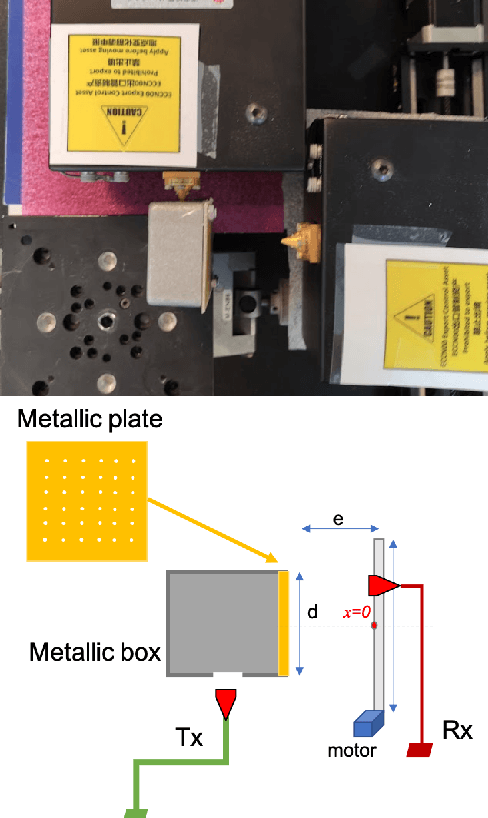
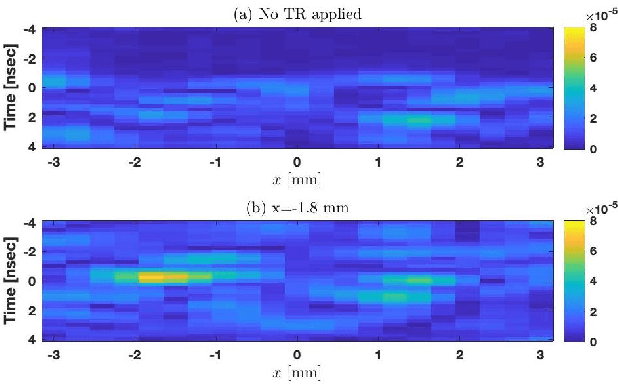
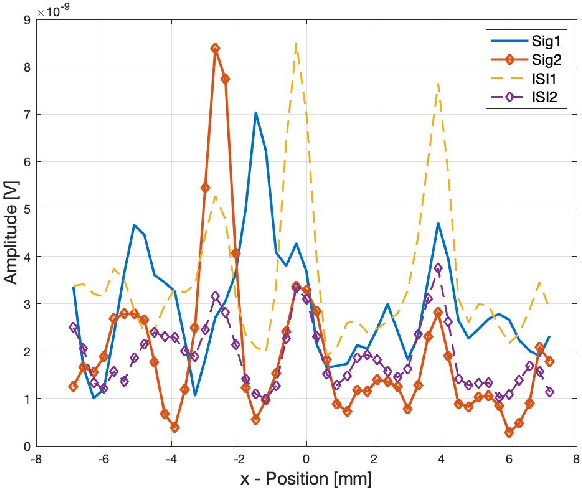

Abstract:Due to availability of large spectrum chunks, the sub-TeraHertz (subTHz) frequency band can support Ultra-WideBand (UWB) wireless communications, paving the way for unprecedented increase in the wireless network capacity. This fact is expected to be the next breakthrough for the upcoming sixth Generation (6G) standards. However, the technology of subTHz transceivers is not yet mature enough to apply the advanced signal processing currently being implemented for millimeter wave wireless communications. In this paper, we consider the Time Reversal (TR) precoding technique, which provides simple and robust processing capable to offer highly focalized in time and space UWB waveforms, exploiting the spatial diversity of wireless channels. We first investigate experimentally the performance of subTHz TR focusing in complex media inside a leaking reverberation cavity. We then combine TR with received spatial modulation to realize data communication using a simple non-coherent receiver with two antennas. Our results showcase the capability of TR to offer focusing in time in the order of few nanoseconds and in space in the order of less than 1 mm.
 Add to Chrome
Add to Chrome Add to Firefox
Add to Firefox Add to Edge
Add to Edge